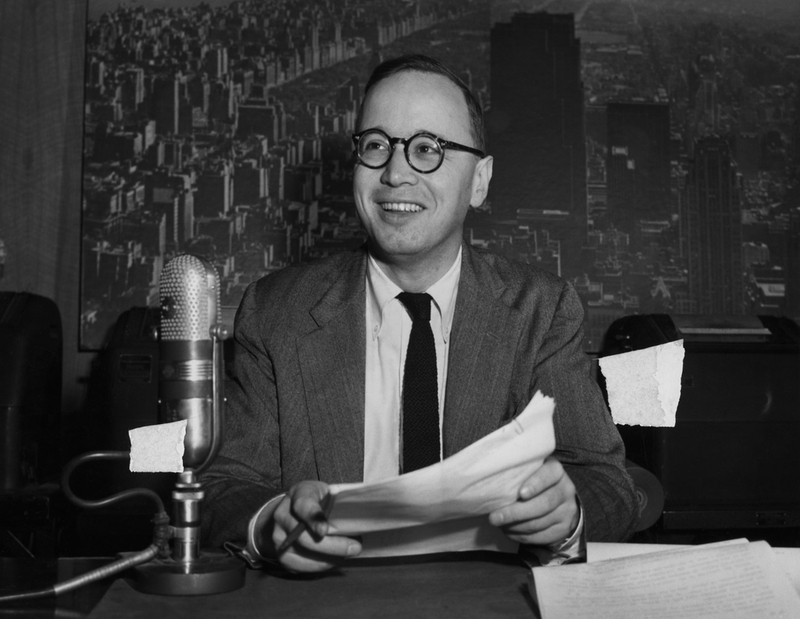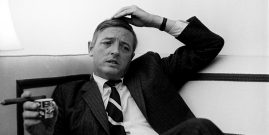Schlesinger, Warts and All
The historian Arthur Schlesinger, Jr. once had a conversation with the President for whom he worked, John Kennedy, in which JFK blasted President Eisenhower, his immediate predecessor, for claiming he had never made a mistake while in office. The history of my administration, JFK instructed Schlesinger, would be a warts-and-all portrait.
If there were one obligation that the dutiful Schlesinger failed to satisfy for his boss, it was this. For the historian would later paint the fallen President as a “King Arthur” whose intent to lead his “subjects” into a golden age of peace and social justice was thwarted by Lee Harvey Oswald. Schlesinger, in other words, violated the canons of his profession, and for the remainder of his life rejected any evidence that compromised his portrait.
Thankfully Richard Aldous, in his often excellent while at the same time frustrating biography of Schlesinger, exhibits much more academic integrity than his subject. In Schlesinger: The Imperial Historian, Aldous applies the balanced treatment that Schlesinger refused to apply to anything Kennedy. The Eugene Meyer Professor of British History and Literature at Bard College does so, moreover, without putting his politics front and center; indeed, the reader will be hard-pressed to learn precisely what they are.
The Schlesinger that emerges from this “warts-and-all” biography is mostly warts. He is everything his detractors, whether of the Right or the Left, said about him. From William F. Buckley to Christopher Hitchens, they charged that the historian owed his career to Arthur Schlesinger, Sr., his pedigreed father, who taught history at Harvard. Aldous shares this view, showing that at every obstacle the son encountered, his father was there to remove it. Dad arm-twisted his Harvard colleagues to assure his son’s attendance at the College, and later gave major publishers the same treatment in getting what was essentially his son’s undergraduate paper into print.
From such nepotistic beginnings, it is difficult to see how Schlesinger could not have been a success. Still, Schlesinger must have disappointed his father; for although liberal, dad was part of a generation of academics who empirically followed a question no matter where it led, even if the answer did not square with their politics.
His son never followed such questions because he already had the answer in hand, which was the moral supremacy of big-government liberalism. And this bias was palpable, down to praising FDR (in The Age of Roosevelt) for his “attractive” chin. It would be Kennedy, though, for whom Schlesinger would fall hardest. The perfect example of this hero-worship was Schlesinger’s giddy treatment of JFK’s performance during the Cuban Missile Crisis: “It was this combination of toughness and restraint, of will, nerve and wisdom, so brilliantly controlled, so matchlessly calibrated, that dazzled the world.”
The real Kennedy was hardly what Schlesinger insisted he was, that is, the heir to the Progressivism of FDR. In fact JFK was a conservative along the lines of a Ronald Reagan. He implemented the first capital gains tax cut, and hated big government, with totalitarian communism being its inexorable outcome, with all the fervor of the Gipper. Biographer Aldous, unlike Schlesinger (who upon hearing that his colleague John Patrick Diggins was about to write a life of Ronald Reagan requested “Please don’t make him look good”), factors in Kennedy’s conservatism and demonstrates that his house historian was always colliding with it.
The relationship of the President and his aide was one of frustration on Schlesinger’s side and irritation on Kennedy’s. Schlesinger was outraged by the Kennedy tax cut, blasting it as “McKinley dogma,” and tried to move the President in a New Deal direction with a flurry of memos and position papers. Kennedy regarded the historian as “a liberal nut,” and the liberalism of the 1930s that Schlesinger so wanted the President to build upon, as outdated.
His (partially Schlesinger-created) image notwithstanding, Kennedy was far from an idealist but was in fact cool and cynical—even thuggish. Aldous accepts that the Kennedy brothers weren’t, as Schlesinger long asserted, ignorant of the CIA-Mafia “wetwork” operations against Cuba’s Fidel Castro but were in fact running them out of the Oval Office.
When the evidence of this grew overwhelming, Schlesinger did concede such involvement, but still hewed to his idealistic portrait by asserting that Attorney General Robert Kennedy, whose feverish desire to bury Castro disturbed even the CIA, was too high-minded to have tolerated the immorality required of these operations, and so must not really have been in the loop.
Schlesinger dealt with these challenges to his ideological and personal biases by constructing a narrative based not on what Kennedy did while in office but on his putative intentions in the last months of his life, and what policies would have emerged from them in a second term. In this version of counter-history, the brothers, in the aftermath of the near-catastrophe of the 1962 Cuban Missile Crisis, transcended their anticommunism and sought to end the Cold War by coming to terms with the Soviets. (Schlesinger was also anticommunist; more, below, on his “transcendence” of it.) This new vision would have purportedly been applied to Castro’s Cuba and the American commitment to South Vietnam.
But the facts say otherwise. President Kennedy died committed to his anticommunist policies regarding those two countries. Mere months before Dallas, the President accelerated the assassination plots against Castro, and requested a contingency plan for another invasion of Cuba. Kennedy also put more energy, and American military troops, into the administration’s support of South Vietnam against the Communist Viet Cong.
In October 1963, the White House supported a military coup that toppled South Vietnam leader Ngo Dinh Diem and resulted in his murder, an involvement that Schlesinger steadfastly denied even when evidence of the brothers’ support for the coup was validated by the Pentagon Papers.
And the motivations for this policy were based not on withdrawing the American advisors to Diem, but to keep the fight against the Vietcong going. The brothers backed the coup out of their fear that Diem was trying to end the war via back-channel negotiations with the communist North.
Meanwhile Schlesinger was working overtime in fashioning plausible deniability scenarios to protect the administration from any blowback from such operations.
Aldous rightly focuses on his subject’s time serving in the White House, and the best visual example of the Schlesingerian giddiness and acute denial of Kennedy’s behavior appears in the book’s photographs. There is a shot in which the historian is grinning from ear to ear against the backdrop of JFK in a close huddle with his current lover, the doomed Marilyn Monroe. In fact, with the bulk of the biography covering the Kennedy period, one is compelled to ask if the historian would have been as famous had he not served in that administration. Aldous, although lauding the historian’s literary gifts as an “eyewitness” historian, doesn’t seem to think he would have been.
Schlesinger does deserve considerable credit for his activism before that period, in the cause of severing legitimate New Deal liberalism from its communist associations formed in the 1930s. What he designated as the “vital center,” peopled by those who rejected fascism and communism alike, in effect salvaged liberalism in the late 1940s, a time when communists, including a KGB agent, were a major constituent part of the presidential campaign of Henry Wallace, a disgruntled former Vice President.
Aldous doesn’t sufficiently value what Schlesinger did in this regard. Indeed, his examination of Schlesinger’s ideological attempts to wrest the New Deal from Stalinist control borders on criticism of his subject. The book’s coverage of Schlesinger’s clear-eyed conclusion that former State Department official Alger Hiss was a Soviet spy segues, revealingly, into a discussion of McCarthyism—the implication being that the influential Schlesinger helped to pave the way for the rise of the demagogic senator from Wisconsin.
It is a pity that Aldous doesn’t highlight how much intellectual courage it took for Schlesinger to condemn Hiss when the controversy surrounding him surfaced in 1948, for he, too, had wrapped himself in the New Deal flag at every opportunity. Hiss and his supporters all insisted that the real reason he was being investigated was to discredit Franklin Roosevelt. He for this reason attracted considerable liberal and Democratic support—including that of Schlesinger’s beloved Eleanor Roosevelt.
But Mrs. Roosevelt eventually shared his concerns about the Democratic Party and its ties to communists or pro-communists. She helped him, along with Walter Reuther and Reinhold Niebuhr, to create the Americans for Democratic Action, which in its inception was the standard-bearer of liberal anticommunism; and she stuck with incumbent President Truman in 1948 and refused to give her imprimatur to the Progressive Party’s heavily communist-assisted candidate, Wallace.
To be fair, Aldous is not in total denial on this subject. He presents Alger Hiss’s fellow New Dealer Laurence Duggan as a Soviet spy based on the same evidentiary sources that exposed Hiss. It was just that Schlesinger, until pretty late in life, defended Duggan as wrongly accused simply because the latter was, ostensibly, at least, a prominent Establishment liberal.
Joseph McCarthy’s labors in the U.S. Senate had a lot of ill-effects, among them flipping Arthur Schlesinger from being a strong anticommunist to being just as fervently (but less honestly) a standard-bearer of anti-anticommunism. Thus in later years could the historian disingenuously insist that it wasn’t the testimony of Hiss’s accuser and once fellow Soviet spy, Whittaker Chambers, that convinced him of Hiss’s guilt but the comments of several New Dealers who worked alongside Hiss in the Agricultural Adjustment Administration in the 1930s.
It was yet another demonstration of how hopelessly partisan Schlesinger was. For Aldous shows that without question, Schlesinger’s conversation with Chambers, during the historian’s research for an article on the American Communist Party, had convinced him of the truth about Hiss two years before the Hiss case broke. Schlesinger had been instrumental in getting Hiss eased out of his State Department job in 1946; he had passed along Chambers’ information to State.
At the conclusion of this book, Aldous contradicts himself by portraying Schlesinger as a master historian in the field of “eyewitness” history, a characterization that is not shared by historians today. In the field he was trained for, Schlesinger failed to follow its objective requirements, and was thus a pioneer of the partisan history that nowadays afflicts us. Ironically, such biased history is practiced by the far Left, even pro-communist, shills then and now whom Schlesinger attacked as counterfeit liberals.



